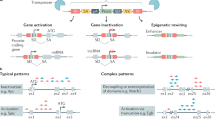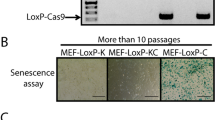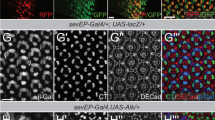Abstract
Genetic screens carried out in lower organisms such as yeast1, Drosophila melanogaster2 and Caenorhabditis elegans3 have revealed many signaling pathways. For example, components of the RAS signaling cascade were identified using a mutant eye phenotype in D. melanogaster as a readout2. Screening is usually based on enhancing or suppressing a phenotype by way of a known mutation in a particular signaling pathway. Such in vivo screens have been difficult to carry out in mammals, however, owing to their relatively long generation times and the limited number of animals that can be screened. Here we describe an in vivo mammalian genetic screen used to identify components of pathways contributing to oncogenic transformation. We applied retroviral insertional mutagenesis in Myc transgenic (EμMyc) mice lacking expression of Pim1 and Pim2 to search for genes that can substitute for Pim1 and Pim2 in lymphomagenesis. We determined the chromosomal positions of 477 retroviral insertion sites (RISs) derived from 38 tumors from EμMyc Pim1−/− Pim2−/− mice and 27 tumors from EμMyc control mice using the Ensembl and Celera annotated mouse genome databases. There were 52 sites occupied by proviruses in more than one tumor. These common insertion sites (CISs) are likely to contain genes contributing to tumorigenesis. Comparison of the RISs in tumors of Pim-null mice with the RISs in tumors of EμMyc control mice indicated that 10 of the 52 CISs belong to the Pim complementation group. In addition, we found that Pim3 is selectively activated in Pim-null tumor cells, which supports the validity of our approach.
This is a preview of subscription content, access via your institution
Access options
Subscribe to this journal
Receive 12 print issues and online access
$209.00 per year
only $17.42 per issue
Buy this article
- Purchase on Springer Link
- Instant access to full article PDF
Prices may be subject to local taxes which are calculated during checkout


Similar content being viewed by others
Notes
NOTE: By error, several corrections were not made to proofs while preparing the manuscript for the press. This has now been corrected in the full-text of the article. The PDF of the article has not been corrected, but a copy of this amendment has been appended to the last page of the PDF. A printed erratum will be published in a forthcoming issue. The following corrections have been made: In the reference list, reference 25 (Losman et al.) has been inserted as reference 13. As a consequence, references 13-24 have been renumbered as 14-25. In the text, the following changes have been made: On page 154, in the second column, reference 16 has been placed at the end of the sentence "These observations underscore the selective advantage..." Reference 16 has also been removed from the first line on page 155. On page 155, in the second column, reference 17 has been placed at the end of the sentence "'Cold' and 'hot' spots for transposon insertions..." On page 157, in the first full paragraph, reference 17 has been changed to reference 18, reference 18 has been changed to reference 19, reference 19 has been changed to reference 20, and reference 25 has been changed to reference 21. On page 158, in the first full paragraph, references 21-23 have been changed to references 22,23.
References
Nasmyth, K. At the heart of the budding yeast cell cycle. Trends Genet. 12, 405–412 (1996).
Wassarman, D.A., Therrien, M. & Rubin, G.M. The Ras signaling pathway in Drosophila. Curr. Opin. Genet. Dev. 5, 44–50 (1995).
Sternberg, P.W. & Han, M. Genetics of RAS signaling in C. elegans. Trends Genet. 14, 466–472 (1998).
Jonkers, J. & Berns, A. Retroviral insertional mutagenesis as a strategy to identify cancer genes. Biochim. Biophys. Acta 1287, 29–57 (1996).
van Lohuizen, M. et al. Predisposition to lymphomagenesis in Pim1 transgenic mice: cooperation with c-Myc and N-Myc in murine leukemia virus-induced tumors. Cell 56, 673–682 (1989).
Selten, G., Cuypers, H.T., Zijlstra, M., Melief, C. & Berns, A. Involvement of c-Myc in MuLV-induced T cell lymphomas in mice: frequency and mechanisms of activation. EMBO J. 3, 3215–3222 (1984).
Verbeek, S. et al. Mice bearing the EμMyc and EμPim1 transgenes develop pre-B-cell leukemia prenatally. Mol. Cell. Biol. 11, 1176–1179 (1991).
Allen, J.D., Verhoeven, E., Domen, J., van der Valk, M. & Berns, A. Pim2 transgene induces lymphoid tumors, exhibiting potent synergy with c-Myc. Oncogene 15, 1133–1141 (1997).
Leverson, J.D. et al. PIM-1 kinase and P100 cooperate to enhance c-Myb activity. Mol. Cell 2, 417–425 (1998).
Mochizuki, T. et al. Physical and functional interactions between PIM-1 kinase and CDC25A phosphatase. Implications for the PIM-1-mediated activation of the c-MYC signaling pathway. J. Biol. Chem. 274, 18659–18666 (1999).
Koike, N., Maita, H., Taira, T., Ariga, H. & Iguchi-Ariga, S.M. Identification of heterochromatin protein 1 (HP1) as a phosphorylation target by PIM-1 kinase and the effect of phosphorylation on the transcriptional repression function of HP1(γ). FEBS Lett. 467, 17–21 (2000).
Ishibashi, Y. et al. PIM-1 translocates sorting NEXIN6/TRAF4-associated factor 2 from cytoplasm to nucleus. FEBS Lett. 506, 33–38 (2001).
Losman, J. et al. IL-4 signaling is regulated through the recruitment of phosphatases, kinases, and SOCS proteins to the receptor complex. Cold Spring Harb. Symp. Quant. Biol. 64, 405–416 (1999).
Rainio, E.M., Sandholm, J. & Koskinen P.J. Cutting edge: transcriptional activity of NFATc1 is enhanced by the PIM-1 kinase. J. Immunol. 168, 1524–1527 (2002).
van der Lugt, N.M. et al. Proviral tagging in EμMyc transgenic mice lacking the Pim1 proto-oncogene leads to compensatory activation of Pim2. EMBO J. 14, 2536–2544 (1995).
Allen, J.D. & Berns, A. Complementation tagging of cooperating oncogenes in knockout mice. Semin. Cancer Biol. 7, 299–306 (1996).
Craig, N.L. Target site selection in transposition. Annu. Rev. Biochem. 66, 437–474 (1997).
Devon, R.S., Porteous, D.J. & Brookes, A.J. Splinkerettes—improved vectorettes for greater efficiency in PCR walking. Nucleic Acids Res. 23, 1644–1645 (1995).
Li, J. et al. Leukaemia disease genes: large-scale cloning and pathway predictions. Nature Genet. 23, 348–353 (1999).
Suzuki, T. et al. Retroviral tagging in the post-genome era identifies new genes involved in cancer. Nature Genet. 32, 86–94 (2002).
Lund, A.H. et al. Genome-wide retroviral insertional tagging of cancer genes in Cdkn2a-deficient mice. Nature Genet. 32, 80–85 (2002).
Miyazawa, K. et al. Recombinant human interleukin-9 induces protein tyrosine phosphorylation and synergizes with steel factor to stimulate proliferation of the human factor-dependent cell line, M07e. Blood 80, 1685–1692 (1992).
Tsuji, K., Lyman, S.D., Sudo, T., Clark, S.C. & Ogawa, M. Enhancement of murine hematopoiesis by synergistic interactions between steel factor (ligand for c-kit), interleukin-11, and other early acting factors in culture. Blood 79, 2855–2860 (1992).
Laird, P.W. et al. In vivo analysis of Pim-1 deficiency. Nucleic Acids Res. 21, 4750–4755 (1993).
Jacobs, H. et al. PIM1 reconstitutes thymus cellularity in interleukin 7- and common γ chain-mutant mice and permits thymocyte maturation in Rag- but not CD3γ-deficient mice. J. Exp. Med. 190, 1059–1068 (1999).
van Lohuizen, M. et al. Identification of cooperating oncogenes in EμMyc transgenic mice by provirus tagging. Cell 65, 737–752 (1991).
te Riele, H., Maandag, E.R., Clarke, A., Hooper, M. & Berns, A. Consecutive inactivation of both alleles of the Pim1 proto-oncogene by homologous recombination in embryonic stem cells. Nature 348, 649–651 (1990).
Cuypers, H.T. et al. Murine leukemia virus-induced T-cell lymphomagenesis: integration of proviruses in a distinct chromosomal region. Cell 37, 141–150 (1984).
Scheijen, B., Jonkers, J., Acton, D. & Berns, A. Characterization of Pal1, a common proviral insertion site in murine leukemia virus-induced lymphomas of c-Myc and Pim1 transgenic mice. J. Virol. 71, 9–16 (1997).
Nakamura, T., Largaespada, D.A., Shaughnessy, J.D. Jr Jenkins, N.A. & Copeland, N.G. Cooperative activation of Hoxa and Pbx1-related genes in murine myeloid leukaemias. Nature Genet. 12, 149–153 (1996).
Acknowledgements
We wish to thank R. Regnerus for assistance in genotyping the mice;N. Bosnie, L. Rijswijk, A. Zwerver, T. Maidment, C. Spaans and F. van der Ahé for animal care; and J. Jonkers and R. van Amerongen for critical reading of the manuscript. This work was supported by the Dutch Cancer Society (H.M.) and the Leukemia Society of America (J.A.).
Author information
Authors and Affiliations
Corresponding author
Ethics declarations
Competing interests
The authors declare no competing financial interests.
Supplementary information
Rights and permissions
About this article
Cite this article
Mikkers, H., Allen, J., Knipscheer, P. et al. High-throughput retroviral tagging to identify components of specific signaling pathways in cancer. Nat Genet 32, 153–159 (2002). https://doi.org/10.1038/ng950
Received:
Accepted:
Published:
Issue Date:
DOI: https://doi.org/10.1038/ng950
This article is cited by
-
Murine leukemia virus (MLV) P50 protein induces cell transformation via transcriptional regulatory function
Retrovirology (2023)
-
Targeting Pim kinases in hematological cancers: molecular and clinical review
Molecular Cancer (2023)
-
Effects of PIM3 in prognosis of colon cancer
Clinical and Translational Oncology (2021)
-
Investigation of monoterpenoid resistance mechanisms in Pseudomonas putida and their consequences for biotransformations
Applied Microbiology and Biotechnology (2020)
-
The first-in-human study of the pan-PIM kinase inhibitor PIM447 in patients with relapsed and/or refractory multiple myeloma
Leukemia (2019)



